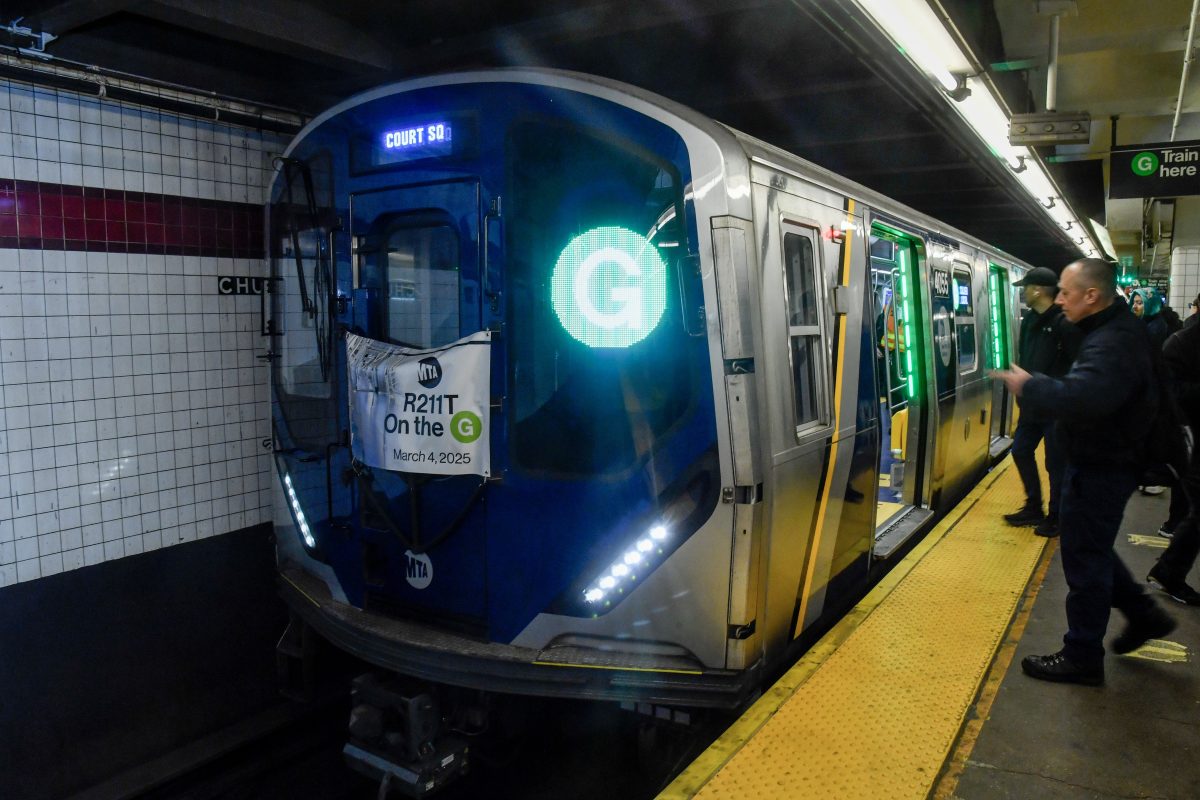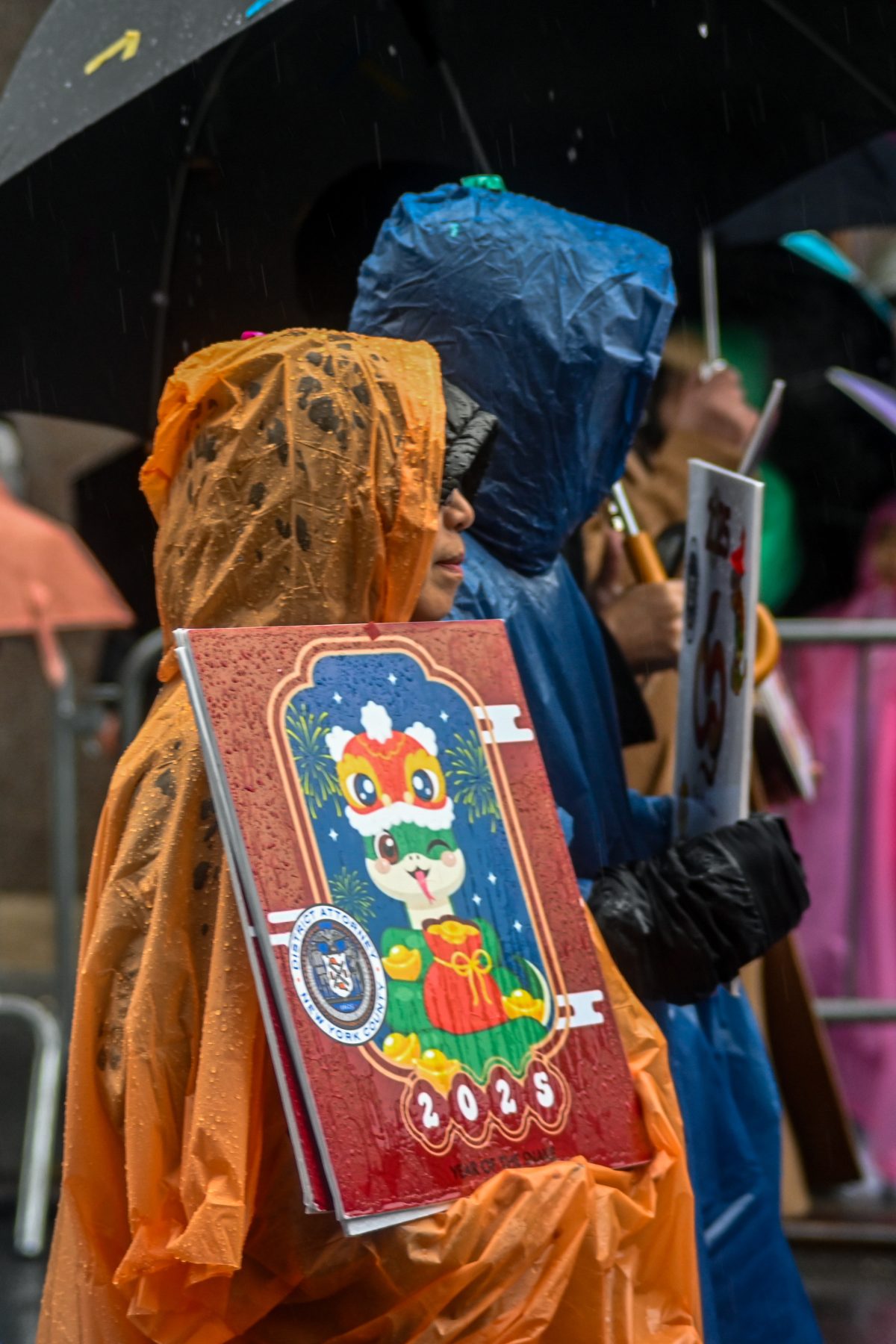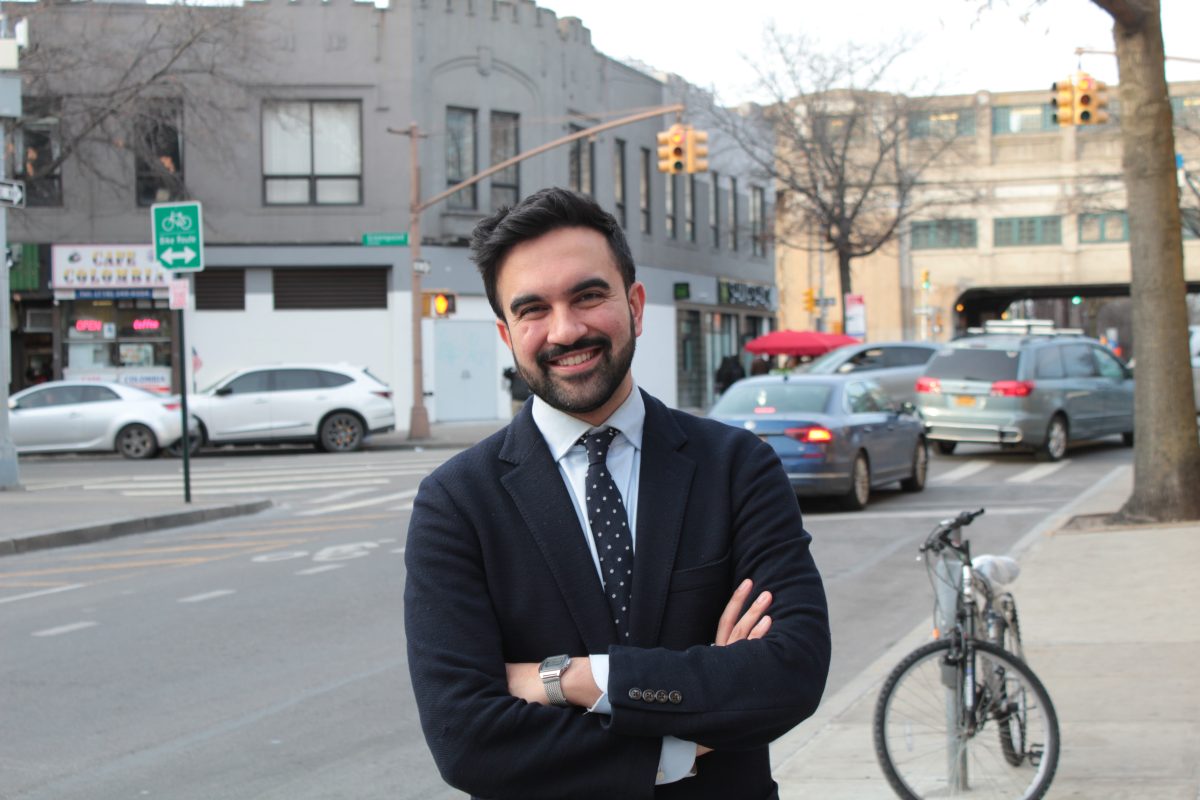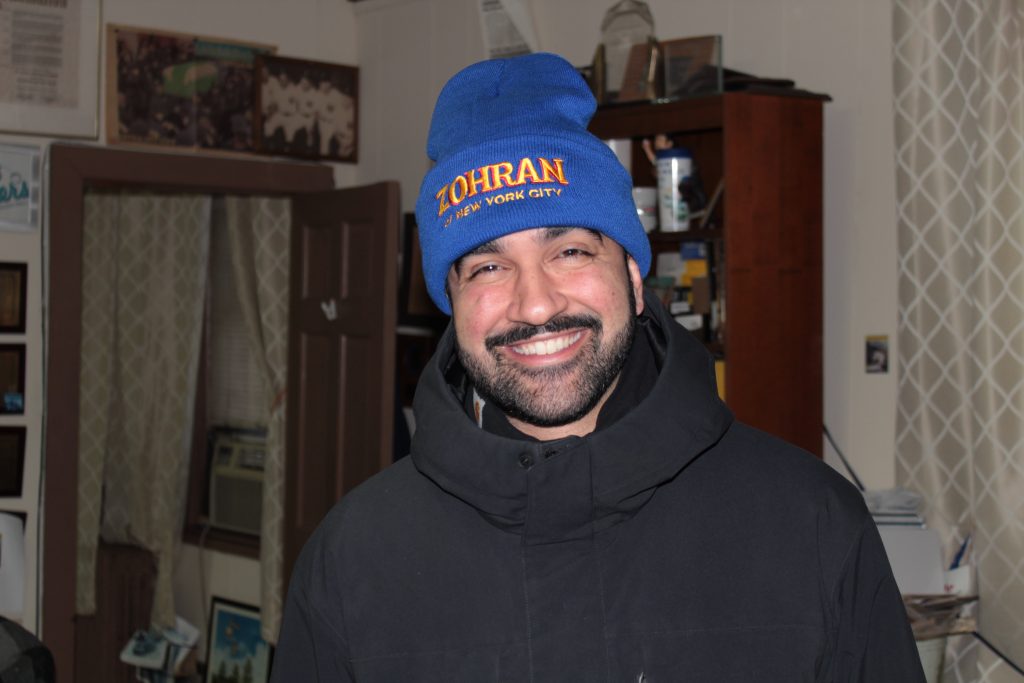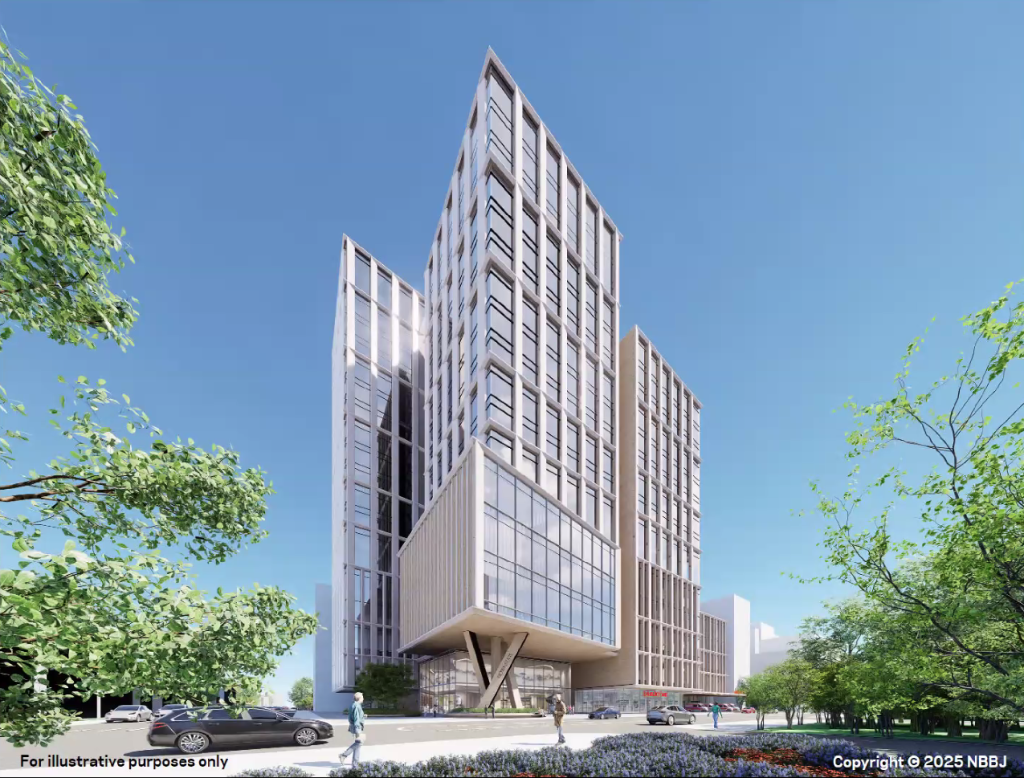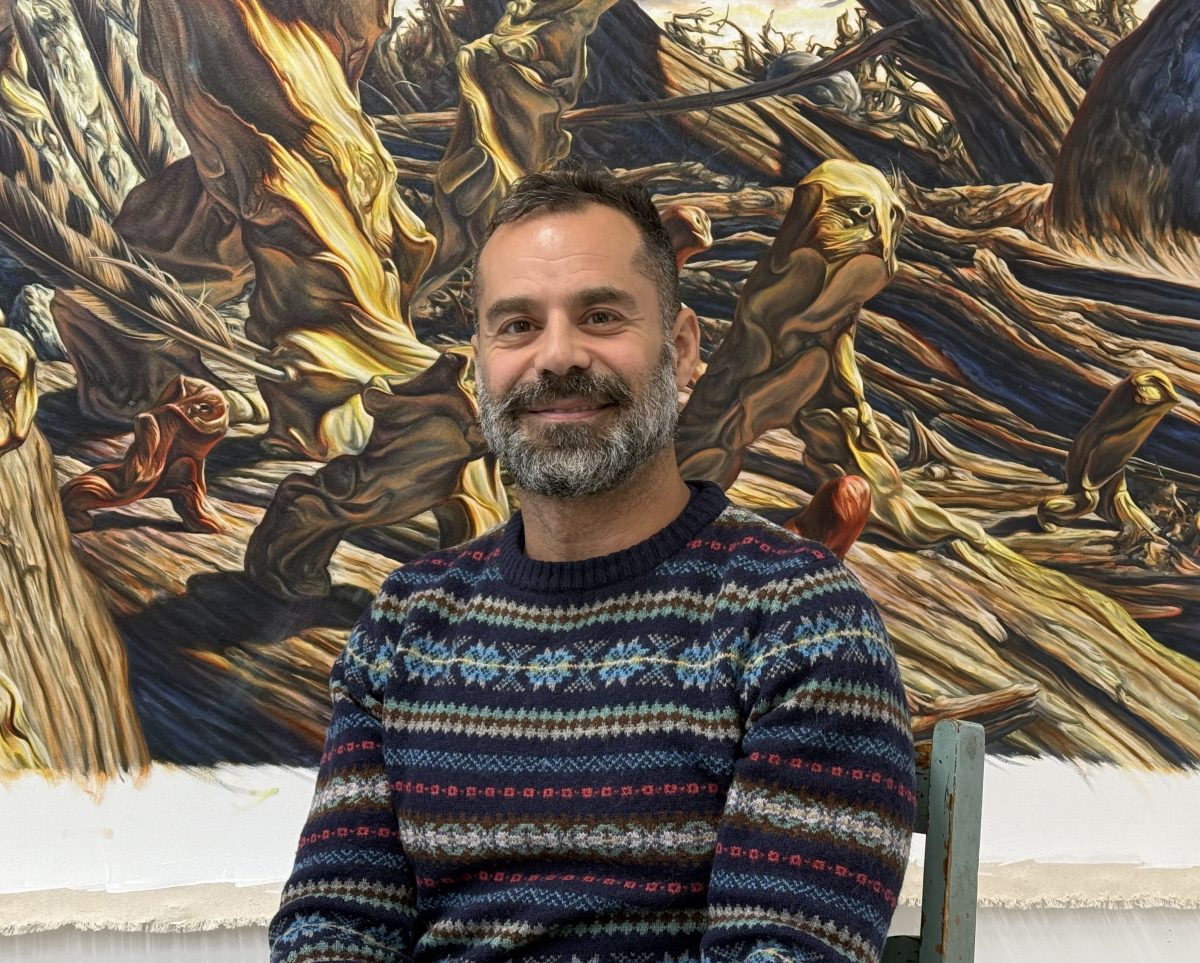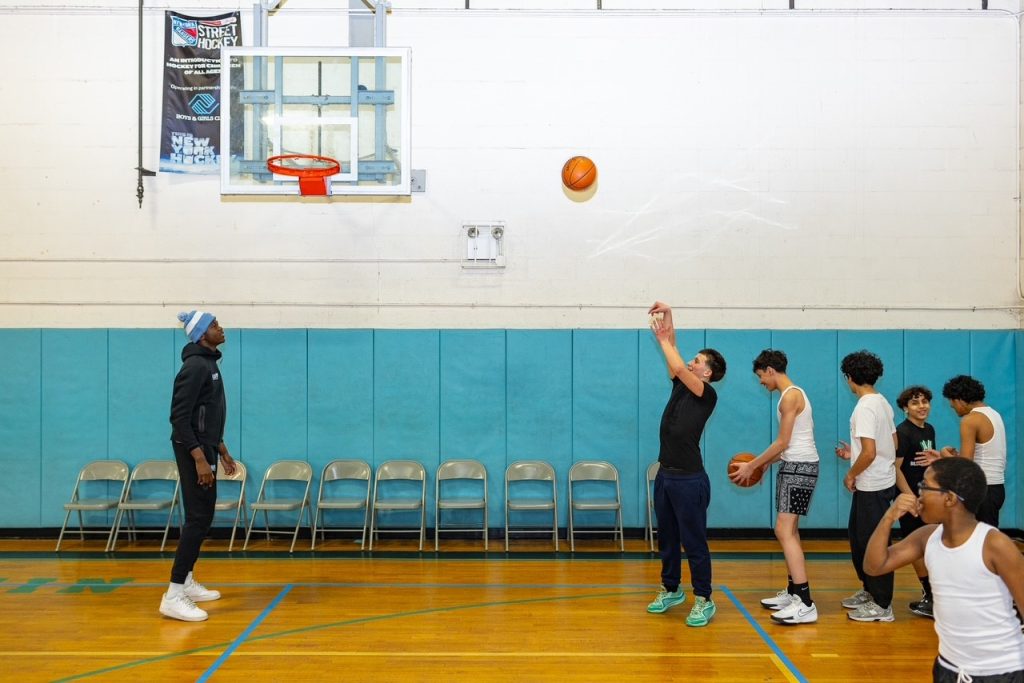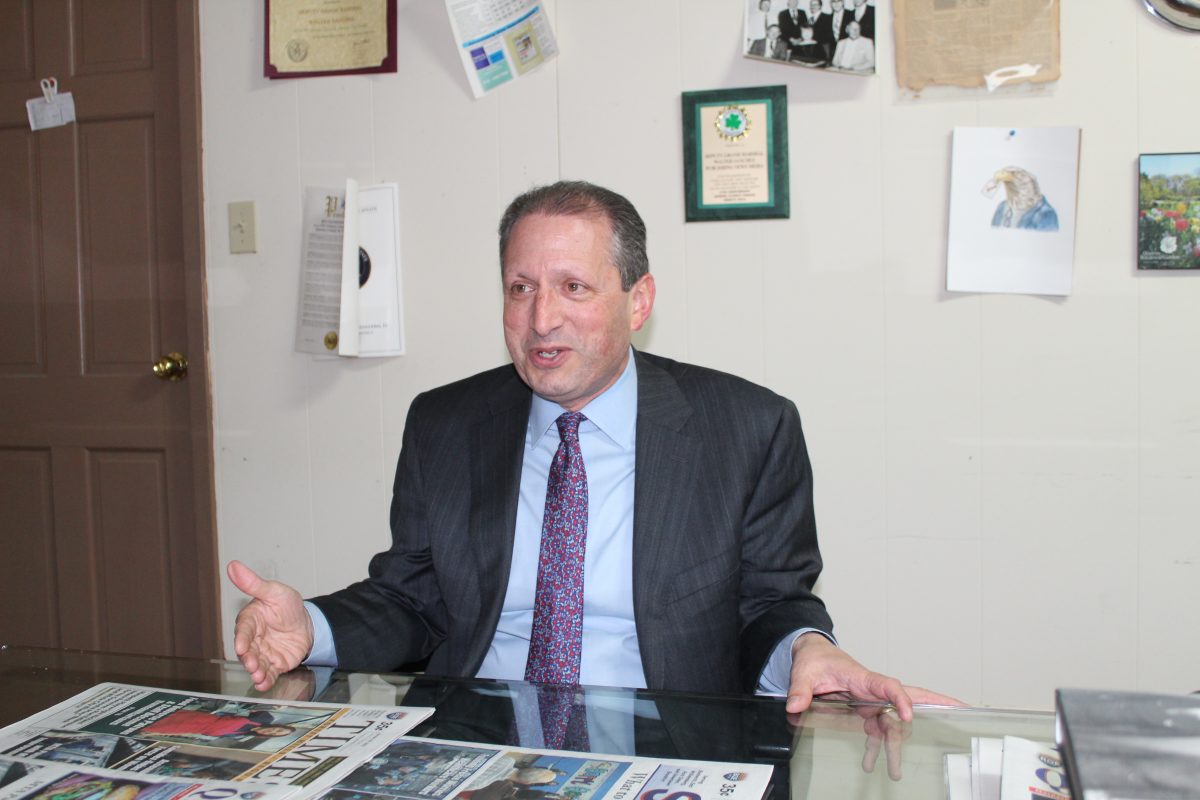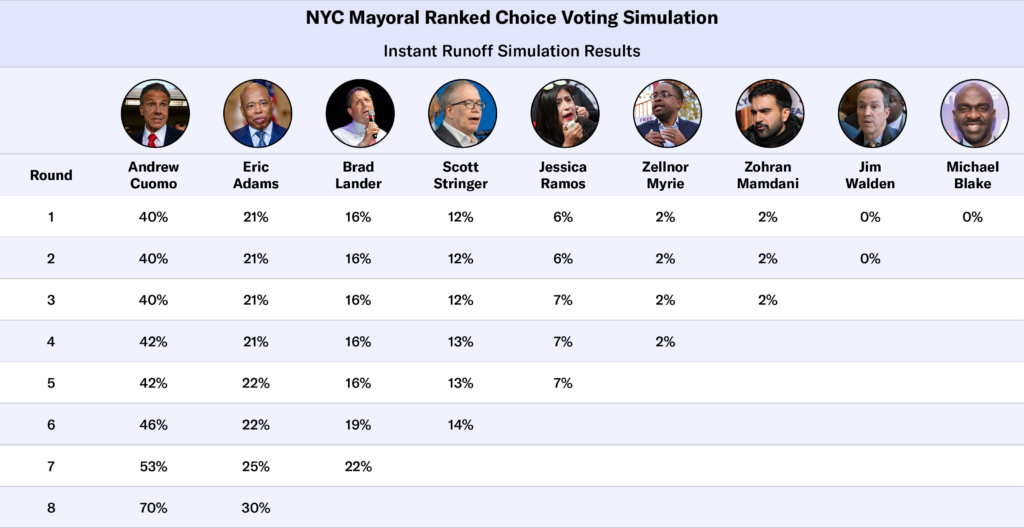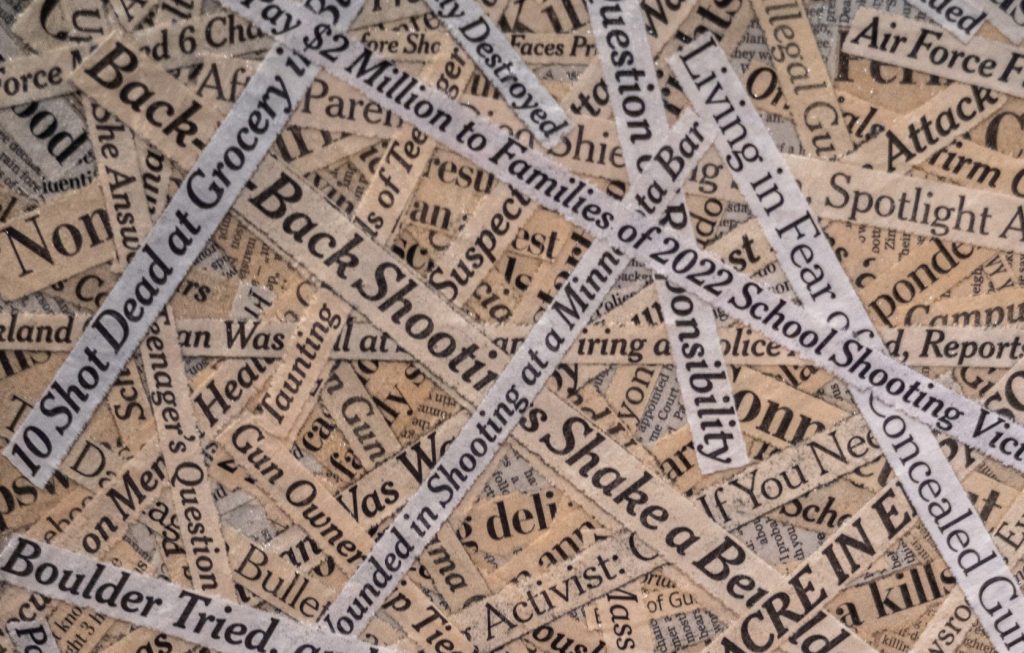
Detail of Shosh Goller’s “Monument to the NRA,” one of many pieces included in the Brooklyn Artists Exhibition at the Brooklyn Museum.
By ALICE MORENO | news@queensledger.com
New York City is easily known as one of the most diverse cities in the country. Thousands of cultures worldwide come together in this one place to live, breathe, and love. Not one story is alike — many come from all walks of life, and it is important to celebrate that aspect.
At the Brooklyn Arts Exhibition, located at the Brooklyn Museum on 200 Eastern Parkway, hundreds of local artists were exhibited. There wasn’t a main idea that followed, instead, many showcased art that described themselves and their experiences, as well as the world around them. Artists used their tools to focus on situations such as queer issues, body image, boyhood, and current events, using their ways to express their thoughts and spark a conversation.
Nevertheless, there is one similarity each artist holds: their connection to the borough of Brooklyn. Whether living there currently or having a long line of ancestry settling in the pre-American Dutch colony, each artist holds the badge of being a Brooklynite high and proud.
I interviewed five local Brooklyn artists who were displayed at the Brooklyn Arts Exhibition. Each artist displayed their work in a thought-provoking manner, leading the audience to dig deep inside to understand themselves and the world they currently live in. These are their stories.
* * *
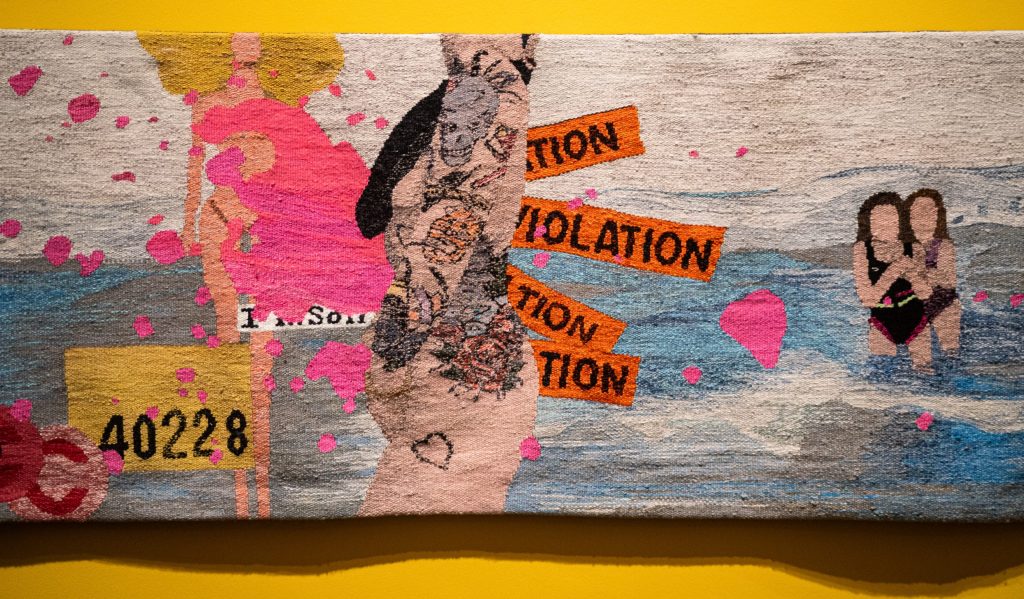
Erin M. Riley, Violations
The complexities of womanhood can oftentimes be a struggle to face. Erin M. Riley, like most women, struggled with being comfortable in her own body. Now, she embraces it, recognizing her body as well as her history as a form of art, in which to be spoken about.
“In college, I wasn’t using my own body. I was using found imagery and stand-ins for me,” said Riley. “But now, as I’ve made [more of] my work and sort of become more comfortable, I’ve been trying to add my body into the pieces, because the work has always been about me.”
The East Williamsburg-based artist created Violations in 2022 as a woven tapestry made out of hand-dyed wool on a cotton wrap. The piece serves as fragments of her memory, discussing personal experiences stemming from the trauma she had faced throughout her childhood.
The tapestry contains a variety of images all connected to the idea of womanhood. With Riley’s body in the middle, it is mirrored by two images depicting her and her sister. Behind her body to the left sits a Barbie doll – known by many as an “idealistic representation” of a woman’s body – and to her right repeats the words “violations” in bright orange, imitating that of a New York City parking ticket. Pink splatter is spread by her body, covering up an apology below it.
For Riley, the most important thing for her is to continue discussing her experiences rather than shunning them.
“Part of me never wants to get tired. I want to sort of keep the conversation [of sexual violence] going,” said Riley. “I like to have these conversations about violations [and] whatever that implies.”
* * *

Shosh Goller’s “Monument to the NRA.” Photo by Alice Moreno
Shosh Goller, Monument to the NRA
Turning on the news to see another mass shooting has become more of a normalization than it should be. Many Americans are desensitized by the news, giving their “thoughts and prayers,” and moving on with their lives. Though many have pleaded to not forget what happened, the commonality of it has led the people to forget anyway.
Shosh Goller, however, does not forget and doesn’t intend to do so for as long as she lives.
The Prospect Heights-based artist created “Monument to the NRA” in 2012 during the wake of the Sandy Hook shooting, and over a decade later, she is still updating the piece. Modeled after the Washington Monument in Washington D.C., the sculpture’s base is made out of chipboard, and it is filled with thousands of headlines ranging from mass shootings to lawmakers’ decisions on gun control.
“I just remember this one story, […] it had nothing to do with gun violence, but it was a story of a woman who was in a fountain in Forest Park [in St. Louis, MI], who was raped, and it was in front of a crowd of people standing around, and no one did anything,” said Goller. “And it just really affected me. And I can’t say that I have any personal connection to gun violence – because I don’t – but it kills me […] day after day of all these incidents that happen.”
When she began the piece, every headline of a shooting – even if there was one casualty – was added to the monument. As the years went on, it became overwhelming to constantly add, therefore Goller currently adds stories with mass headlines. The latest headline added was that of Trump’s assassination attempt in July 2024.
As the years went on, each headline began to yellow, serving as a testimony of a long-running issue in this country. Goller has also created similar pieces using headlines, such as one designed as the Twitter logo, sporting Trump’s haircut and a mask, surrounded by headlines discussing the issues of the COVID-19 Pandemic. Another features a women’s upper body, with headlines about sexual assault allegations all from the #MeToo movement.
“I keep offering [the piece] to politicians, thinking they can put it in their office for people who come in to show how awful this situation is,” said Goller “But so far, I don’t have any takers.”
* * *

Avram Finklestein’s “Golem 11/71 (BRAF V600E selfie).” Photo by Alice Moreno
Avram Finklestein, Golem 11/71 (BRAF V600E selfie)
Avram Finklestein’s story is that of resilience. His disability does not stop him from creating art – instead, he embraces it, being a frequent theme in his work.
Golem 11/71 serves as a testament to that. As his disability – degenerative neuromuscular disease, which leads his muscle to atrophy – worsened his ability to do art in the long run, Finklestein operated a wheeled metal structure that doubled as a mobility device to be able to roam around his studio. After he finished and took the work of the wall, he realized the translucency of the matte acetate could lead to creating two pieces in one – birthing his self-portrait. One side reflected himself at age 11 and age 71 on the other.
Between the portraits surround a plethora of live-cell imagery of cancer and plasma cells. Battling cancer, Finklestein notes the importance of recognizing disabilities – even if it isn’t clearly visible.
‘And then it started me thinking about the invisibility of [disabilities] and the ways in which […] the person next to us on the subway train could be in pain, but we would have no way of knowing that,” said Finklestein. “What we can see about the world has nothing to do with how the world actually functions.”
As the years pass, Finklestein’s work has moved from social issues to more personal ones. He hopes to use his skills to help people understand him on a deeper level, especially by focusing on the issues he faces with his health.
Rather than making precise, realistic work, Finklestein opts for a more abstract look, feeling as it makes it more honest – not only with himself but with others. His emotions are evident in the piece, whether he is an 11-year-old child in a Xerox photograph using his coat to mask his face or using technology in an advanced world, with 70 years of experience behind him.
“My hands don’t obey me. My body just doesn’t obey me. But I refuse to stop,” said Finklestein. “I can’t see, but I refuse to stop making work.”
* * *
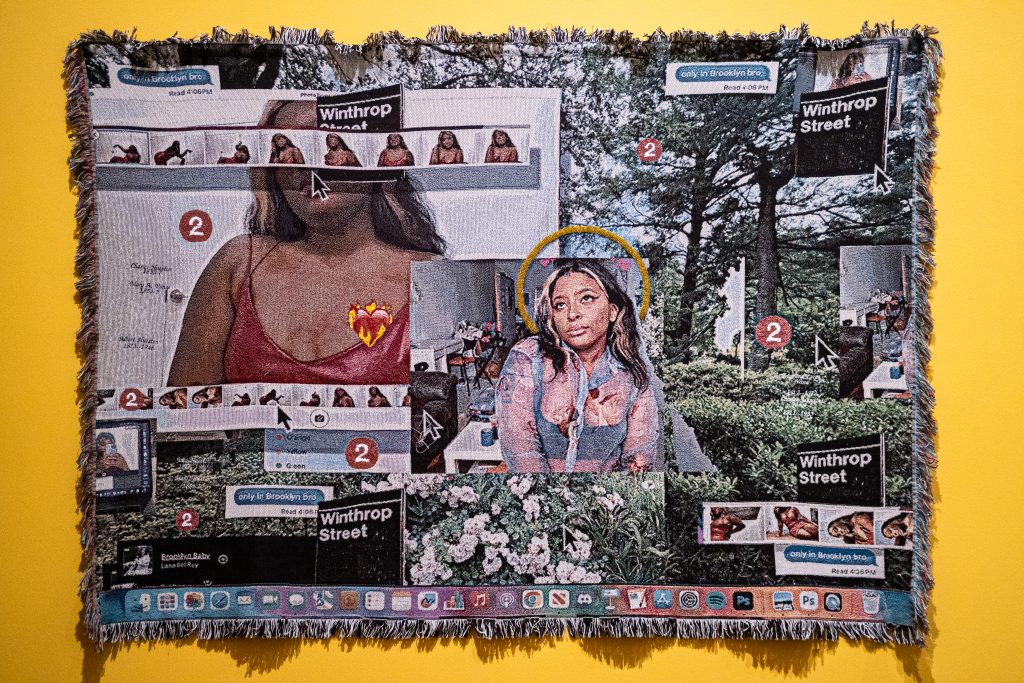
Qualeasha Wood’s “Brooklyn Baby.” Photo by Alice Moreno
Qualeasha Wood, Brooklyn Baby
Qualeasha Wood has a deep connection to Brooklyn. Her ancestor, Charlie Hueston, escaped slavery by fleeing from Tennessee to Canada and eventually settled in Brooklyn. Brooklyn became the home for her family throughout the 20th century, as her parents and grandparents grew up and met in the borough.
In Brooklyn Baby, Wood’s love for the borough — despite not living there, as she is based in New Jersey — family and loved ones shine through, with her descendants’ names being displayed on the piece. The machine-embroidered tapestry featured the subway signage for “Winthrop Avenue,” the block her family grew up in, and the symbol for the 2 train, which she depended on during her time in Brooklyn. The background for the piece is an image of the Brooklyn Botanical Gardens, where she had her first date with her fiancée. The title of the piece derives from the Lana Del Rey song “Brooklyn Baby,” a satirical piece focusing on out-of-towners who live and breathe Brooklyn.
The piece is intermingled with the theming of identity. As a queer, black woman, Wood is finding her role in a society that caters to the cis, white man. A Photobooth app selfie of Wood takes up most of the tapestry, dating from the years she lived in Brooklyn.
“I think right now, as we were all on our phones and just absorbed with the world, it’s so important to kind of just dial it in and just be a little more in our direct sphere, and within our own communities,” said Wood.
Wood hopes for people to enjoy the now with the people they love the most. She is close to her family, inviting them to many of her exhibitions and art events and even helping her with embroidering her pieces. Despite making a last-minute decision to change her career from joining the Air Force — the route her parents chose for her life — to attending art school, her family is still her biggest supporter.
* * *
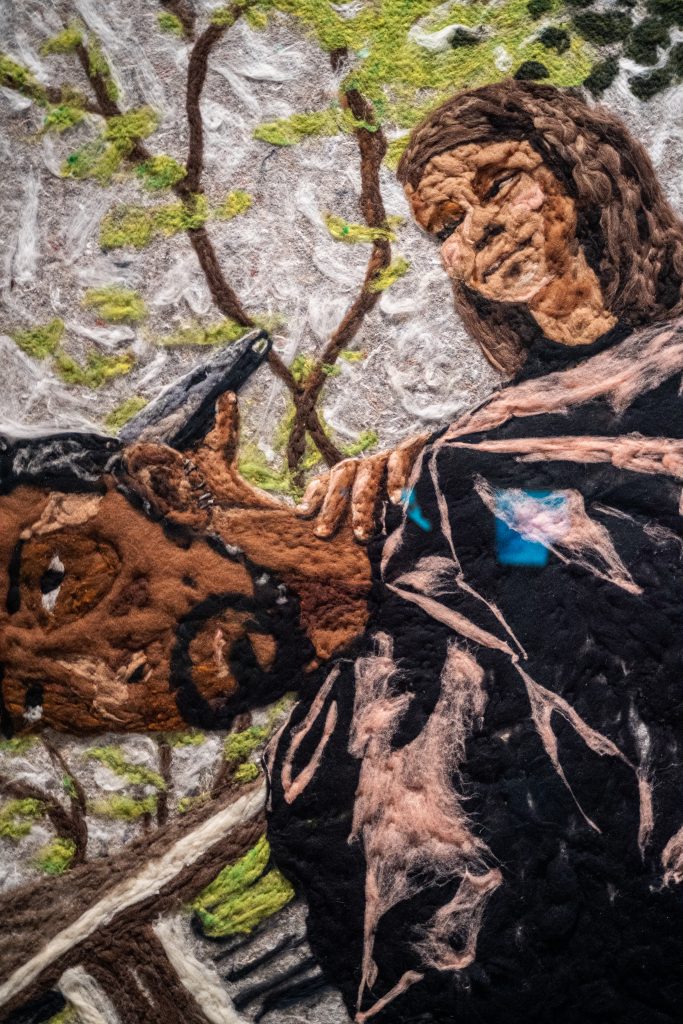
Melissa Joseph’s “Olive’s Hair Salon.” Photo by Alice Moreno
Melissa Joseph, Olive’s Hair Salon
As a biracial, Indian, and white woman, Melissa Joseph strives for others to see themselves in her work. Each moment with her family is special and unique, meshing together to create a melting pot of culture. To her, these moments feel special – even if it was a small event, Joseph strives to recognize her culture in her work.
Olive’s Hair Salon is a special moment for her. During the COVID-19 Pandemic, many were left to DIY certain services that they would otherwise pay for, including haircuts. During a Zoom call with Joseph’s family, her brother planned to buzz his hair off completely in his backyard. His daughter offered to help and held the clippers upside down. Finding it humorous, Joseph snapped a photo.
“I try to like represent moments, sometimes everyday things that people can recognize themselves in,” said Joseph. “But also, it’s important to me to show kind of like imagery of South Asian culture and biracial culture, mixed families […] the funny things that happen when multiple cultures come together.”
Joseph notes that after seeing artist Henry Taylor’s work at the Whitney Museum in Manhattan – specifically the piece “Gettin it Done,” in which he had painted his neighbors getting a haircut in the vibrant community of Downtown L.A. – she realized that there was a sort of intimacy with getting a haircut. There is a high level of trust given to barbers, as many want their hair to be cut in a specific way. She compared the level of intimacy between a barber with their client and her brother and his young daughter, interested in the amount of trust her brother gave to his daughter, even if she held the clippers incorrectly.
Using wool and felt, Joseph noticed that there was a sort of contradiction. She uses a process called needle felting, in which she pokes the fibers through the surface. Though it is a meditative process, there is an underlying sense of violence: since she uses her images as a base, she “stabs” each image over and over. It took Joseph a while to understand that poking the piece over and over is a part of the narrative, noting that at the end of the process, the fibers are softly woven through the piece, feeling like a fluffy cloud.
The human experience can be simple to others but truly has some artistic measure to it. Joseph proves this with her work, letting the audience know that they too can familiarize themselves with other people’s stories, seeing themselves and their lives in her work.
Joseph was awarded the UOVO Prize, given by the Brooklyn Museum to honor emerging artists in Brooklyn. She was awarded a cash prize of $25,000, an outdoor installation at the museum, and a mural displayed outside of UOVO Brooklyn in Bushwick. UOVO serves as a storage facility and logistics provider for fine arts, fashion, and wine.
BQE Admin
on
March 14, 2025


